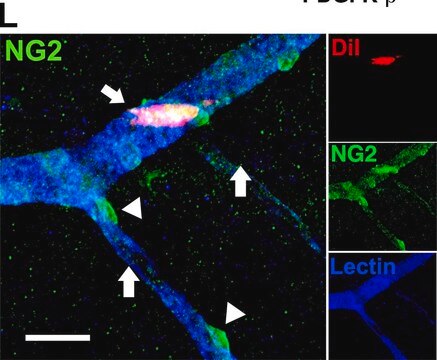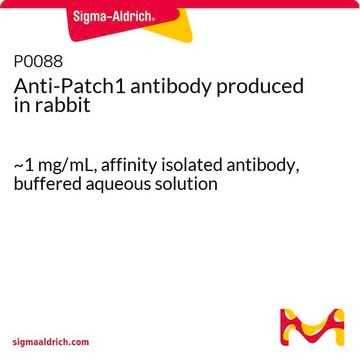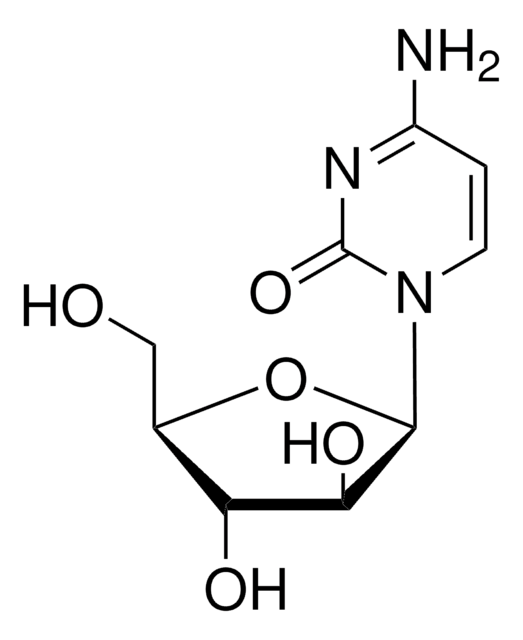MAB338
Anti-Ciliary Neurotrophic Factor Antibody, clone 4-68
clone 4-68, Chemicon®, from mouse
Synonym(s):
CNTF
Sign Into View Organizational & Contract Pricing
All Photos(1)
About This Item
UNSPSC Code:
12352203
eCl@ss:
32160702
NACRES:
NA.41
Recommended Products
biological source
mouse
Quality Level
antibody form
purified antibody
antibody product type
primary antibodies
clone
4-68, monoclonal
species reactivity
mouse, rat, human, monkey
manufacturer/tradename
Chemicon®
technique(s)
immunohistochemistry: suitable
western blot: suitable
isotype
IgG1
NCBI accession no.
UniProt accession no.
shipped in
wet ice
target post-translational modification
unmodified
Gene Information
human ... CNTF(1270)
Specificity
Ciliary neurotrophic factor. Detects a 22 kD band in Western blots of rat sciatic nerve extract.
Immunogen
Purified ciliary neurotrophic factor from rat sciatic nerve.
Application
Immunohistochemistry: 10-20 μg/mL on frozen sections of rat sciatic nerve perfused and counter-fixed with 4% paraformaldehyde (Stockli et al., 1991).
Western blotting: 10 μg/mL (Stockli et al., 1991)
Optimal working dilutions must be determined by the end user.
Western blotting: 10 μg/mL (Stockli et al., 1991)
Optimal working dilutions must be determined by the end user.
Research Category
Neuroscience
Neuroscience
Research Sub Category
Neurochemistry & Neurotrophins
Neurochemistry & Neurotrophins
This Anti-Ciliary Neurotrophic Factor Antibody, clone 4-68 is validated for use in WB, IH for the detection of Ciliary Neurotrophic Factor.
Physical form
Format: Purified
Liquid in 0.02M phosphate buffer, 0.25M NaCl with 0.1% sodium azide, pH 7.6.
Storage and Stability
Maintain at 2-8°C for up to 6 months. Avoid repeated freeze/thaw cycles.
Other Notes
Concentration: Please refer to the Certificate of Analysis for the lot-specific concentration.
Legal Information
CHEMICON is a registered trademark of Merck KGaA, Darmstadt, Germany
Disclaimer
Unless otherwise stated in our catalog or other company documentation accompanying the product(s), our products are intended for research use only and are not to be used for any other purpose, which includes but is not limited to, unauthorized commercial uses, in vitro diagnostic uses, ex vivo or in vivo therapeutic uses or any type of consumption or application to humans or animals.
Not finding the right product?
Try our Product Selector Tool.
wgk_germany
WGK 2
flash_point_f
Not applicable
flash_point_c
Not applicable
Certificates of Analysis (COA)
Search for Certificates of Analysis (COA) by entering the products Lot/Batch Number. Lot and Batch Numbers can be found on a product’s label following the words ‘Lot’ or ‘Batch’.
Already Own This Product?
Find documentation for the products that you have recently purchased in the Document Library.
Ten years of human metapneumovirus research.
F Feuillet,B Lina,M Rosa-Calatrava,G Boivin
Journal of Clinical Virology null
Cuihong Jia et al.
Glia, 66(11), 2456-2469 (2018-12-01)
Astrocyte-derived ciliary neurotrophic factor (CNTF) promotes adult subventricular zone (SVZ) neurogenesis. We found that focal adhesion kinase (FAK) and JNK, but not ERK or P38, repress CNTF in vitro. Here, we defined the FAK-JNK pathway and its regulation of CNTF
Katsusuke Hata et al.
Neuroreport, 13(5), 735-739 (2002-04-26)
Ciliary neurotrophic factor (CNTF) attracts considerable attention because it supports survival and differentiation of various types of neurons and glial cells in vitro. Although CNTF functions as a moderate neurotrophic factor in mature motor neurons, its role in embryonic development
Milena Girotti et al.
Neuropharmacology, 160, 107791-107791 (2019-09-26)
Deficits in cognitive flexibility, i.e. the ability to modify behavior in response to changes in the environment, are present in several psychiatric disorders and are often refractory to treatment. However, improving treatment response has been hindered by a lack of
Anna Polosa et al.
International journal of molecular sciences, 20(11) (2019-06-07)
To unravel the mechanisms behind the higher resistance to light damage of juvenile (JR) versus adult (AR) rats, Sprague Dawley rats were exposed to a bright luminous environment of 10, 000 lux. The light-induced retinopathy (LIR) was assessed with histology
Our team of scientists has experience in all areas of research including Life Science, Material Science, Chemical Synthesis, Chromatography, Analytical and many others.
Contact Technical Service




